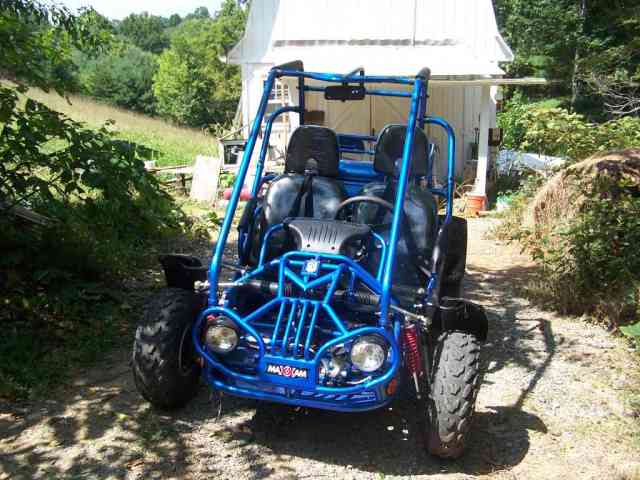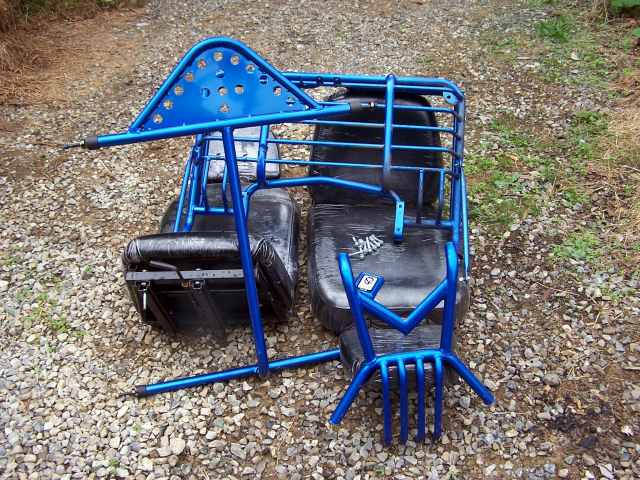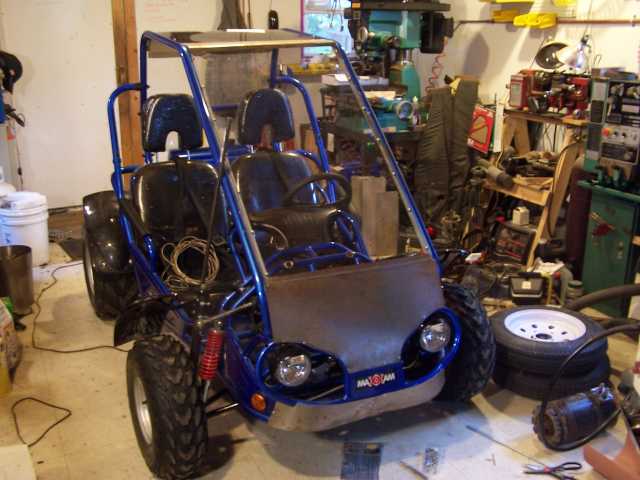 Here we see the thing as delivered from Northern Hydraulics. You
can see plenty of extra gingerbread on the front, which we will
be removing, as well as the package tray on the back that doesn't
show in this picture. We also checked those bucket seats, and they
weigh on the order of several times what a normal car seat does,
as well as being too high and too far forward for adult humans.
So, the first step is to strip off all the extra weight and other
dumb things in preparation for putting a body on her (this seems
to be a girl car, rather than a boy or an it), and a real
seating arrangement. I can barely tolerate the seatbelt harnesses,
and will leave them for now, even though they have a nasty projection
right behind your neck for a bolt that'd kill you in a crash.
Here we see the thing as delivered from Northern Hydraulics. You
can see plenty of extra gingerbread on the front, which we will
be removing, as well as the package tray on the back that doesn't
show in this picture. We also checked those bucket seats, and they
weigh on the order of several times what a normal car seat does,
as well as being too high and too far forward for adult humans.
So, the first step is to strip off all the extra weight and other
dumb things in preparation for putting a body on her (this seems
to be a girl car, rather than a boy or an it), and a real
seating arrangement. I can barely tolerate the seatbelt harnesses,
and will leave them for now, even though they have a nasty projection
right behind your neck for a bolt that'd kill you in a crash.
Specs from the service manual:
Weight: 341 lbs dry
Power: 9 Hp from a 150cc 9.2::1 compression bike type engine
Fuel tank: 1.54 gal
Wheelbase: 57 in long, about 47 in wide (front and rear are different)
Brakes: All wheel hydraulic disks
Steering: rack and pinion
This is not the kind of go–kart Doug grew up with, to say the least.
Those were pretty miserable, especially in brakes (keds!) and handling.
This is pretty nice as is.
Doug used to be a serious motor head, so we can bet that 9 hp figure won't be true for very long. Neither will the weight. After stripping off the junk and putting back what we want, we should be about even there, but might gain or lose a bit. The stuff we're taking off is heavy after all, and the things we're adding are not so heavy, except the windshield. At its current 38 lbs/hp, it is surprisingly peppy up to about 30 mph, when the CV transmission runs out of ratio. We seem to be getting about 50 mph top speed on the flat with current gearing, but that is one thing that will be changed. The current limit on speed isn't power, it's engine revs. No need for this to be able to climb 45 degree slopes, as it currently will. Gas milage is in the "great" category, but until we do some measured runs, can't be stated here yet. Got to replace that picture of an odometer on the dash with the real thing to measure it easily. One can drivethe thing all day long without running it out of gas, though.
 There was a surprising amount of excess junk associated with this
kart design. We found the gingerbread on the front especially
annoying, as it seems designed to push the steering column through
the driver in the event of a crash. We'd rather have at least a little
crumple zone instead, which we now have, though the floor steel is
still somewhat too thick for that. The package tray was a lot
of extra weight, and placed high, raising the center of gravity.
As it was also the gas tank mount, new small brackets were fabricated
to replace that function and powdercoated. There seems to be an
amazing amount of steel in those bucket seats. Normal auto seats
are a thin skin of foam over some thin springs. Not these, which
take more than one hand to lift. At any rate, due to fit issues, they
place the rider too high and too far forward for comfort if the rider
is a normal sized adult. So, out they go, and we will replace them
with a more comfortable bench seat made of foam and fabric, which
won't have to be rock hard, like the buckets are. Not shown in this
picture is one of the rear springs, which was removed to get the
spring rate correct for the reduced weight. We will be looking for
new coil-over shocks for the back end to make a more permanent correction
to this problem. The way it was, the rear suspension was at its
upper limit even with Doug jumping up and down on the driver area.
Rides better now, to say the least.
There was a surprising amount of excess junk associated with this
kart design. We found the gingerbread on the front especially
annoying, as it seems designed to push the steering column through
the driver in the event of a crash. We'd rather have at least a little
crumple zone instead, which we now have, though the floor steel is
still somewhat too thick for that. The package tray was a lot
of extra weight, and placed high, raising the center of gravity.
As it was also the gas tank mount, new small brackets were fabricated
to replace that function and powdercoated. There seems to be an
amazing amount of steel in those bucket seats. Normal auto seats
are a thin skin of foam over some thin springs. Not these, which
take more than one hand to lift. At any rate, due to fit issues, they
place the rider too high and too far forward for comfort if the rider
is a normal sized adult. So, out they go, and we will replace them
with a more comfortable bench seat made of foam and fabric, which
won't have to be rock hard, like the buckets are. Not shown in this
picture is one of the rear springs, which was removed to get the
spring rate correct for the reduced weight. We will be looking for
new coil-over shocks for the back end to make a more permanent correction
to this problem. The way it was, the rear suspension was at its
upper limit even with Doug jumping up and down on the driver area.
Rides better now, to say the least.
 Here's the cart in the shop. The polycarbonate windshield is so
clear it is hard to see in this picture. The motor in the lower
right is what we would use to make it all electric, if we go there.
The tires on the floor might get modified to match the wierd bolt
circle the cart uses, which is of course different on the front and
the back. We'll save the old tires for off–roading, but are
seriously in need of wheels and tires that say "DOT approved"
on them.
The windshield is pretty heavy, being 1/4" thick polycarbonate.
For the first attempt
1/8" plexiglass was tried, but I wound up wearing that and the bird
I hit at top speed, so we went to better stuff. We are using mostly
22 ga steel for body parts that aren't plastic or wood. No additional
strength appears to be needed, just a way to keep the wind, weather
and high velocity bugs out. This drives very "tight",
no flex or twist is noticeable. The center of gravity is just at the
back of the seating area, in the middle. If jacked up there, all 4
wheels come off the ground at once; sort of handy to be able to twirl
the thing around while working on it.
Here's the cart in the shop. The polycarbonate windshield is so
clear it is hard to see in this picture. The motor in the lower
right is what we would use to make it all electric, if we go there.
The tires on the floor might get modified to match the wierd bolt
circle the cart uses, which is of course different on the front and
the back. We'll save the old tires for off–roading, but are
seriously in need of wheels and tires that say "DOT approved"
on them.
The windshield is pretty heavy, being 1/4" thick polycarbonate.
For the first attempt
1/8" plexiglass was tried, but I wound up wearing that and the bird
I hit at top speed, so we went to better stuff. We are using mostly
22 ga steel for body parts that aren't plastic or wood. No additional
strength appears to be needed, just a way to keep the wind, weather
and high velocity bugs out. This drives very "tight",
no flex or twist is noticeable. The center of gravity is just at the
back of the seating area, in the middle. If jacked up there, all 4
wheels come off the ground at once; sort of handy to be able to twirl
the thing around while working on it.We are finding that this goes faster at lower throttle as we are adding things to it. The best guess is that it is becoming a bit more aerodynamic. It will never be as good as the current crop of teardrop shaped autos, as Doug and the rest of the crew aren't into serious compound curves in sheet metal, but it is so small things work out anyway. We are looking into reducing the ground clearance somewhat to see what effect that has. Right now it is more than needed for a road car (over 5"), and may have air rotors or other turbulence going on down there that slow us down. Current day autos and especially racers have an air dam there to keep pressure from building up under the car for this reason.
 Doug could not resist putting this picture up here, with helper
Anna Corder doing her best Bob Barker pose as a goof.
Anna did the seating,
and did a darn fine job. A 6 foot normal human now fits without
any cramping, and it's comfortable with extra lumbar support.
She likes driving this thing too, but is really
looking forward to it having a heating system, as it is beginning to
get chilly here in the mountains. We think we can take off the
engine cooling air for that function. Doug got some super bright led
arrays from DigiKey for turn signals, backup lights and so on.
These are Lamina Light Engines, and they are so bright as to be scary --
looking into one for a fraction of a second produces serious
afterimages. We won't have trouble with tailgaters once one of
these 350 lumen lights is turned on.
Expensive ($24 ea or so right now),
but worth it. We'll probably have to use a variable dimmer to make them
truly correct for the job. That way we can just turn them up to blinding
when there's a problem being noticed.
Doug could not resist putting this picture up here, with helper
Anna Corder doing her best Bob Barker pose as a goof.
Anna did the seating,
and did a darn fine job. A 6 foot normal human now fits without
any cramping, and it's comfortable with extra lumbar support.
She likes driving this thing too, but is really
looking forward to it having a heating system, as it is beginning to
get chilly here in the mountains. We think we can take off the
engine cooling air for that function. Doug got some super bright led
arrays from DigiKey for turn signals, backup lights and so on.
These are Lamina Light Engines, and they are so bright as to be scary --
looking into one for a fraction of a second produces serious
afterimages. We won't have trouble with tailgaters once one of
these 350 lumen lights is turned on.
Expensive ($24 ea or so right now),
but worth it. We'll probably have to use a variable dimmer to make them
truly correct for the job. That way we can just turn them up to blinding
when there's a problem being noticed.
You can see the paper template we are using to see what metal would look like put into the same place, as we want to keep the cute factor alive here. We've painted some of the metal, some with car paint, some with powder coating. The piece of wood at the back will have to be replaced with clear or tinted plastic to allow backing up in close quarters; you live and learn. Soon it will be hard to just stick your head out the side to see, and that's one of the cut and try things we are finding out here. Though not shown in this picture, Doug has added a tailpipe south of the muffler which really quiets the thing down without noticeable power losses. We are working with various panel resonances as well to get this thing acceptably quiet in use. The main trouble spot at present is the windshield, which goes into resonance right at the engine torque peak, yuck. We might have to put a non– transparent bar across someplace to help control this one. The metal parts are no trouble so far, with undercoating and carpet glued on to them. The observant reader will notice that we've already gotten a county tax sticker on this. That part was easy, all they need is money and maybe a VIN, which this actually did have. Safety inspection needs all the usual stuff, which we want anyway, but the State (VA) is going to be the real bear, as the state vehicular code is obtuse, spread around a few million pages of other law, and basically is set up to make things easy for big guys (think a million dollars for crash and pollution testing if you don't already own a certified lab) and impossible for innovators. This we plan to have changed. What politician will want to go on TV to explain why he is supressing the used to be mythical, but in this case, actual, 250 mpg carburator at these fuel prices? The news anchor and state cop are lined up already. As are the crowds for witnesses and support. It can be nice to live in a small town...